Nsci 175 exam 2 answers - Study guides, Class notes & Summaries
Looking for the best study guides, study notes and summaries about Nsci 175 exam 2 answers? On this page you'll find 36 study documents about Nsci 175 exam 2 answers.
Page 3 out of 36 results
Sort by
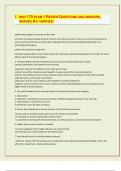
-
NSCI 175 EXAM 1 REVIEW QUESTIONS AND ANSWERS, GRADED A+/ VERI| 2024/2025 Exam PREDICTIONS|FIED/
- Exam (elaborations) • 8 pages • 2024
-
Available in package deal
-
- $8.99
- + learn more
NSCI 175 EXAM 1 REVIEW QUESTIONS AND ANSWERS, GRADED A+/ VERIFIED/ explain why progress in science is often slow Scientists are always putting forward theories and what you hear in class is our current understand of science but those theories and ideas get challenged and new understandings develop with new technology and progress explain the reductionist approach scientists break problems into smaller pieces for systematic experimental analysis, size of the unit study defines what is ...
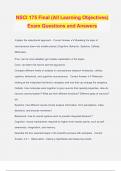
-
NSCI 175 Final (All Learning Objectives) Exam Questions and Answers
- Exam (elaborations) • 80 pages • 2024
-
- $13.49
- + learn more
NSCI 175 Final (All Learning Objectives) Exam Questions and Answers Explain the reductionist approach - Correct Answer ️️ -Breaking the topic of neuroscience down into smaller pieces (Cognitive, Behavior, Systems, Cellular, Molecular). Pros: can be more detailed; get a better explanation of the topics Cons: can bterm-0e hard to see the big picture Compare different levels of analysis in neuroscience research (molecular, cellular, systems, behavioral, and cognitive neuroscience) - Cor...
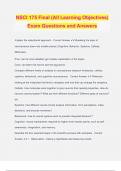
-
NSCI 175 Final (All Learning Objectives) Exam Questions and Answers
- Exam (elaborations) • 80 pages • 2024
-
- $13.49
- + learn more
NSCI 175 Final (All Learning Objectives) Exam Questions and Answers Explain the reductionist approach - Correct Answer ️️ -Breaking the topic of neuroscience down into smaller pieces (Cognitive, Behavior, Systems, Cellular, Molecular). Pros: can be more detailed; get a better explanation of the topics Cons: can bterm-0e hard to see the big picture Compare different levels of analysis in neuroscience research (molecular, cellular, systems, behavioral, and cognitive neuroscience) - Cor...
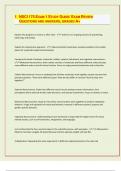
-
NSCI 175 EXAM 1 STUDY GUIDE/ EXAM REVIEW QUESTIONS AND ANSW| 2024/2025 Exam PREDICTIONS|ERS, GRADED A+
- Exam (elaborations) • 6 pages • 2024
-
Available in package deal
-
- $8.49
- + learn more
NSCI 175 EXAM 1 STUDY GUIDE/ EXAM REVIEW QUESTIONS AND ANSWERS, GRADED A+ Explain why progress in science is often slow - -Science is an ongoing process of questioning, observing, and testing Explain the reductionist approach - -Neuroscientists break down complex problems into smaller pieces for systematic experimental analysis Compare the levels of analysis: molecular, cellular, systems, behavioral, and cognitive neuroscience - -Molecular Neuroscience: Brain matter consists of molecul...

-
NSCI 175 Exam 2 Questions with complete Answers 2023
- Exam (elaborations) • 13 pages • 2023
-
Available in package deal
-
- $20.49
- + learn more
NSCI 175 Exam 2 Questions with complete Answers 2023 Acetylcholine (ACh) is the main transmitter used at which mammalian junctions? neuromuscular junctions The cholinergic drug atropine _______ receptors. A. activates nicotinic B. blocks muscarinic C. activates muscarinic D. blocks nicotinic B. blocks muscarinic The NMDA receptor is a type of receptor for the neurotransmitter glutamate In the mammalian brain, the major inhibitory neurotransmitter is GABA. ...
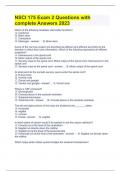
-
NSCI 175 Exam 2 Questions with complete Answers 2023
- Exam (elaborations) • 13 pages • 2023
-
Available in package deal
-
- $19.99
- + learn more
NSCI 175 Exam 2 Questions with complete Answers 2023 Which of the following mediates vital bodily functions? A. Cerebrum B. Brain stem C. Cerebellum D. Meninges B. Brain stem Axons of the nervous system are described as afferent and efferent according to the direction in which they carry information. Which of the following represents an efferent projection? A. Interneurons in the spinal cord B. Motor output of the spinal cord C. Sensory input to the spinal cord, Motor output of t...
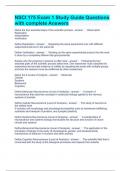
-
NSCI 175 Exam 1 Study Guide Questions with complete Answers
- Exam (elaborations) • 14 pages • 2023
-
Available in package deal
-
- $19.99
- + learn more
NSCI 175 Exam 1 Study Guide Questions with complete Answers Name the four essential steps of the scientific process Observation Replication Interpretation Verification Define Replication Repeating the same experiment over with different subjects/animals but in the same lab Define Verification Working on the same experimental protocol but the work is done by a completely different lab group/scientist Explain why the progress in science is often slow Following the fou...

-
NSCI 175 Exam 1 Study Guide Questions with complete Answers 2023
- Exam (elaborations) • 5 pages • 2023
-
Available in package deal
-
- $18.99
- + learn more
NSCI 175 Exam 1 Study Guide Questions with complete Answers 2023 Explain why progress in science is often slow Science is an ongoing process of questioning, observing, and testing Explain the reductionist approach Neuroscientists break down complex problems into smaller pieces for systematic experimental analysis Compare the levels of analysis: molecular, cellular, systems, behavioral, and cognitive neuroscience Molecular Neuroscience: Brain matter consists of molecules and the...
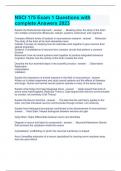
-
NSCI 175 Exam 1 Questions with complete Answers 2023
- Exam (elaborations) • 9 pages • 2023
-
Available in package deal
-
- $19.99
- + learn more
NSCI 175 Exam 1 Questions with complete Answers 2023 Explain the Reductionist Approach Breaking down the study of the brain into multiple components (Molecular, cellular, systems, behavioral, and cognitive) Compare different levels of analysis in neuroscience research Molecular: The study of the brain at its most elementary level Cellular: Focuses on studying how all molecules work together to give neurons their special properties Systems: Constellations of neurons form complex circu...
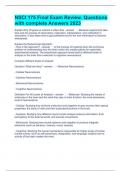
-
NSCI 175 Final Exam Review. Questions with complete Answers 2023
- Exam (elaborations) • 26 pages • 2023
-
Available in package deal
-
- $22.49
- + learn more
NSCI 175 Final Exam Review. Questions with complete Answers 2023 Explain Why Progress in science is often slow -Because experiments take time and the process of observation, replication, interpretation, and verification is exhaustive. It also takes time to get published and for the new information to become widespread. Explain the Reductionist Approach: - How is the Approach? Is the process of breaking down the enormous problem of understanding how the brain works into smaller pieces ...

How did he do that? By selling his study resources on Stuvia. Try it yourself! Discover all about earning on Stuvia


